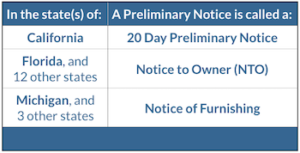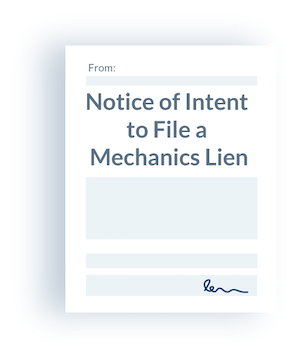
Spend any time around a construction project and there’s a pretty good chance that you’re going to hear the word “notice” get mentioned, often multiple times – and perhaps for different reasons – on the same project. Even though there are just 2 main types of construction notices, it’s easy to confuse them due to their similar-sounding names. So, what’s the difference between Preliminary Notice vs. Notice of Intent to Lien?
Preliminary Notices and Notices of Intent to Lien are the Most Common Construction Notices
In short, a Preliminary Notice (called a “Notice of Furnishing” or “Notice to Owner” in some states) is a document that lets the recipient (usually the property owner, general contractor, and any other participants that may affect your payment) know who you are and what kind of work and/or materials you are performing. A Notice of Intent (also called a “Notice of Intent to Lien”) is a type of warning document that lets the recipient know you plan to file a lien against the property if you aren’t paid for the work you performed. Typically, subcontractors, material suppliers, and other parties lower on the payment chain file preliminary notices and notices of intent.
Read the Ultimate Guide to Preliminary Notice in Construction
Most states require these construction notices to protect your lien rights, although each state has its own notice requirements. Read on for more detail on both types of notices.
What is a Preliminary Notice?
Sending preliminary notice is a requirement almost everywhere in the United States.
When required, sending preliminary notice is the first step to securing lien rights on a construction project. Failing to send a required preliminary notice or missing the deadline usually invalidates lien rights and eliminates the ability to file a mechanics lien in the event of nonpayment. Not sure if you need to send preliminary notice on a project? Visit Levelset’s Payment Rights Advisor and enter your project info, we’ll tell you if a notice is due in when for free.
Even when preliminary notice isn’t necessary, it’s usually incredibly beneficial to send one. These notices keep the property owner, GC, and other top-of-chain parties in the loop regarding the work you’re performing, which prioritizes your invoice. It also helps build strong working relationships by creating transparency on the project.
Think of a preliminary notice as a precaution rather than a reaction. Contractors typically file preliminary notices at the beginning of a project, sometimes before project work has even commenced, and almost always well before any payment problems arise. It’s a low-cost insurance vehicle specially designed for the construction industry.
A couple of things to remember about preliminary notices:
- A preliminary notice is a tool recommended for any construction company nationwide, but in some states, it’s required in order to secure lien rights.
- A preliminary notice can go by many different names, depending on the state the project is in. Here is just a partial list of the different names that some states use for “preliminary notice”: 20 Day Preliminary Notice (California), Notice to Owner, or NTO (Florida and 12 other states), and Notice of Furnishing (Michigan and 3 other states).
For more information, please see:
- Preliminary Notice FAQs for all 50 states
- Why You Should Send Preliminary Notice Even If It’s Not Required
What is a Notice of Intent to Lien (NOI)?
The Notice of Intent to Lien (NOI) is best thought of as the construction industry’s equivalent of a demand letter or dunning letter. Typically, it’s the second step in the lien rights process, after sending the preliminary notice, and before filing a lien claim.
NOIs have the extra benefit of being relevant to parties other than the debtor and carry more overall weight. This results in demanding more attention and producing more success. In fact, Levelset customers have reported that sending an NOI results in payment within 20 days from delinquent customers 47% of the time. Need help sending an NOI? Click here to send an NOI in minutes.
States that Require these Construction Notices
9 states require that a Notice of Intent to Lien must be sent on private projects before a construction party is allowed to file a mechanics lien (the deadlines to send the NOIs in these 9 states vary). Click the state below to download read more about notices and requirements.
There are no NOI requirements before filing a bond claim on state, federal, or other public works construction projects.
For more information, please see:






